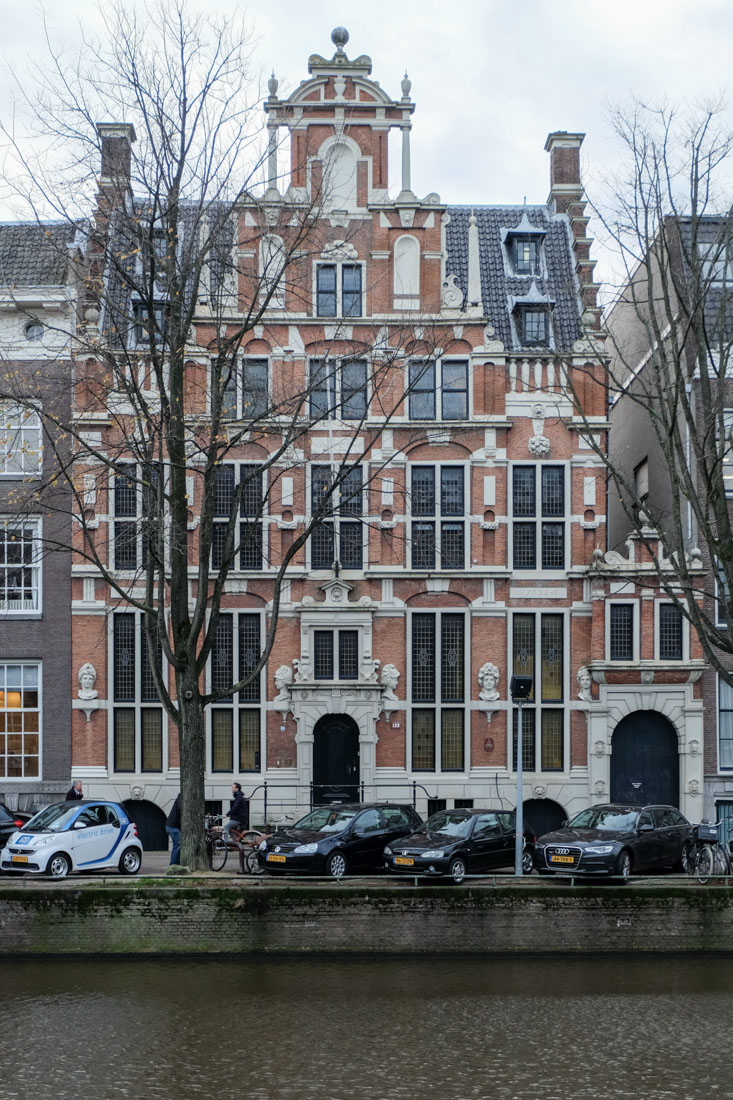 |
 |
 |
 |

Huis met de Hoofden
Keizersgracht 123, Amsterdam
1622
The
so-called "Huis mit de Hoofden", built in 1622, is
attributed to the architects Hendrick and Pieter
de Keyser. It was built for the rich hosiery
merchant and art lover Nicolaas Sohier. He had acquired
two extra-wide plots of land as well as additional land
from the houses behind on the Herengracht. This allowed
the garden to be laid out particularly deep.
The Renaissance façade is extraordinarily fine and richly decorated by Amsterdam standards. In the lower section, the façade is divided by wide pilasters. Above this, narrower pilasters are arranged in pairs. The stepped gable is decorated with vases and free-standing columns. On both sides of the gable, the roof is partly concealed by balustrades, so that the façades appear higher. The main entrance to the building is centrally located in the main façade. To the right of the portal is a gateway leading to the coach house. Above the gate was the coachman's chamber. The building owes its name to the six heads that decorate the façade. These are representations of six gods with their attributes: Apollo, Ceres, Mercurius, Minerva, Bacchus and Diana.
The magnificent house in Dutch Renaissance style is located on the Keizersgracht in Amsterdam. Today, the building is one of the most significant monuments in Amsterdam and since 2017 has housed the Embassy of the Free Mind Museum, which contains the Bibliotheca Philosophica Hermetica (BPH).
The Renaissance façade is extraordinarily fine and richly decorated by Amsterdam standards. In the lower section, the façade is divided by wide pilasters. Above this, narrower pilasters are arranged in pairs. The stepped gable is decorated with vases and free-standing columns. On both sides of the gable, the roof is partly concealed by balustrades, so that the façades appear higher. The main entrance to the building is centrally located in the main façade. To the right of the portal is a gateway leading to the coach house. Above the gate was the coachman's chamber. The building owes its name to the six heads that decorate the façade. These are representations of six gods with their attributes: Apollo, Ceres, Mercurius, Minerva, Bacchus and Diana.
The magnificent house in Dutch Renaissance style is located on the Keizersgracht in Amsterdam. Today, the building is one of the most significant monuments in Amsterdam and since 2017 has housed the Embassy of the Free Mind Museum, which contains the Bibliotheca Philosophica Hermetica (BPH).
Das
sogenannte "Huis mit de Hoofden" mit Baujahr 1622 wird den
Architekten Hendrick und Pieter de Keyser zugeschrieben.
Es wurde für den reichen Strumpfwarenhändler und
Kunstliebhaber Nicolaas Sohier erbaut. Dieser hatte zwei
extrabreite Grundstücke sowie zusätzliches Land von den
Häusern dahinter an der Herengracht erworben. Dadurch
konnte der Garten besonders tief angelegt werden.
Die
Renaissancefassade ist für Amsterdamer Verhältnisse
ausserordentlich fein und reichhaltig verziert. Im unteren
Bereich wird die Fassade durch breite Pilaster gegliedert.
Darüber sind jeweils schmalere Pilaster paarweise
angeordnet. Der abgetreppte Giebel ist mit Vasen und
freistehenden Säulen ausgestaltet. Beidseits des Giebels
wird das Dach zum Teil durch Balustraden verdeckt, so dass
die Fassaden höher wirken. Der Hauptzugang zum Gebäude ist
zentral in der Haupfassade angeordnet. Zur rechten Seite
des Portals befindet sich eine Pforte welche zum
Kutschhaus führt. Über der Pforte befand sich die Kammer
des Kutschers. Seinen Namen verdankt das Gebäude den sechs
Köpfen welche die Fassade zieren. Es handelt sich dabei um
die Darstellungen von sechs Göttern mit ihren Attributen:
Apoll, Ceres, Mercurius, Minerva, Bacchus und Diana.
Das prächtige Haus im niederländischen Renaissancestil befindet sich an der Keizersgracht in Amsterdam. Das Gebäude zählt heute zu den bdeutenden Monumenten in Amsterdam und beherbergt seit 2017 das Museum "Embassy of the Free Mind", in welchem sich die Bibliotheca Philosophica Hermetica (BPH) befindet.
Das prächtige Haus im niederländischen Renaissancestil befindet sich an der Keizersgracht in Amsterdam. Das Gebäude zählt heute zu den bdeutenden Monumenten in Amsterdam und beherbergt seit 2017 das Museum "Embassy of the Free Mind", in welchem sich die Bibliotheca Philosophica Hermetica (BPH) befindet.
